Us Embassy
-
- Regulatory Crewing Challenges for Offshore Wind Vessels Maritime Reporter, Jul 2019 #14
Every day we see more and more news about how the planning for new offshore wind projects continues to expand with the increasing investment from both domestic and foreign interests in these projects. This is resulting in both developers and contractors making logistics plans to secure vessels and crew for the purposes of meeting the demands necessary to crew and operate vessels in support of future wind farm operations.
Unfortunately, there are challenges associated with the evolving federal regulatory regime that are developing with this nascent industry facing both U.S.- and foreign-flag vessel owners and operators related to the crewing of such vessels. Despite universal federal agency support for offshore wind farms, due to the varying ways in which federal agencies are applying crewing laws and the Outer Continental Shelf Lands Act (OCSLA) to offshore wind farms, this is resulting in a different regime in many ways compared to how these laws have been applied over the years to oil and gas projects on the Outer Continental Shelf (OCS). The following is a discussion of these challenges.
With regard to foreign-flag vessels, as a general rule, under OCSLA, vessels engaged in “OCS activities” must use U.S. citizens to crew such vessels. However, there is an exemption procedure available under OCSLA which allows foreign-flag vessels that are over 50% foreign owned or controlled by foreign citizens to engage in U.S. OCS activities using foreign crew members. A formal application to the Coast Guard is required to obtain such an exemption. Upon approval of the exemption, the foreign citizen crew members will be able to obtain a B-1 (OCS) visa from a U.S. embassy in order to allow them off the vessel in the United States, or travel to the United States, to meet a vessel. Crew members are not able to obtain the B-1 (OCS) visa until the Coast Guard exemption letter is issued.
Unfortunately, the Coast Guard will not grant an OCS crewing exemption to a foreign-flag vessel engaged in offshore wind farm operations because it has determined that the crewing restrictions under OCSLA only apply to the employment of personnel on units engaged in an “OCS activity” on the U.S. OCS. This term is defined by the Coast Guard to mean “any offshore activity associated with the exploration for, or development or production of, the minerals of the OCS.” The definition of “minerals” has been interpreted by the U.S. Coast Guard to not include wind.
However, an analysis of the statutory authority reveals that the Coast Guard’s interpretation is incorrect. Neither the U.S. citizen manning requirement nor the exemption procedure for this requirement limits its mandate to mineral activities. Indeed, the specific authorization that gives BOEM the authority to approve the development and construction of a wind energy project on the OCS, is authorized pursuant to a 2005 amendment to OCSLA, to specifically expand this authority beyond the production of oil and gas on the OCS. Similarly, OCSLA also authorizes the Coast Guard to regulate the health and safety of workers and facilities offshore without distinguishing between projects that produce minerals or other energy. However, we understand that the Coast Guard takes the position that it does not have the authority to regulate an offshore wind farm under this provision because it is not an activity related to the minerals of the seabed.
Accordingly, a vessel engaged in wind operations on the OCS is not subject to the OCSLA crewing restrictions and can employ foreign citizens without obtaining a crewing exemption from the Coast Guard. The problem with this outcome is that the foreign crew member cannot obtain a B-1 (OCS) which has a six-month maximum stay period. One would think that the next most logical option given the Coast Guard’s position would be a D-Visa. Such a visa option, however, creates a conundrum because the crew members performing wind farm related work on such a vessel must depart the United States within (29) days which is not a long enough time to complete a typical wind farm project offshore.
Indeed, this problem is further exacerbated when an individual applies for a visa at a U.S. embassy for offshore wind farm work on the OCS.
Embassies expect that a person applying for a visa for OCS work will possess a Coast Guard crewing exemption letter and as a result some embassies are refusing to issue a B-1 visa to the applicant. As a result, the Coast Guard’s interpretation is causing confusion with regard to the need for crew members to obtain a B visa (without an OCS annotation) to be issued by a U.S. embassy. We believe a B-type visa is the appropriate visa to issue in these circumstances which would provide crew members with the time needed to complete a wind farm project on the U.S. OCS.
This development is also causing confusion with regard to how U.S. Customs and Border Protect (“CBP”) officials make U.S. entry decisions when a crew member receives a visa and arrives at an airport or on a wind farm project on the OCS. The representative for the local CBP port director is confused because typically they are used to seeing a crew member arrive with a B-1 (OCS) visa for energy related work on the OCS. Accordingly, this is also resulting in uncertainty in how visa rules will be interpreted by local CBP officials.
Fortunately, as a result of these developments, we understand discussions with relevant Coast Guard, CBP, and State Department officials in Washington D.C. have recently been taking place which hopefully will result in new approaches and agency coordination on the proper policy on issuing B-1 visas to crewmen who will work on offshore wind projects on the U.S. OCS.
With regard to U.S.-flag vessels, absent some exceptions, the officers and unlicensed seamen crew aboard a U.S.-flag vessel must be U.S. citizens. It has not been uncommon in the past for companies to place persons aboard a U.S.-flag vessel to perform special operations that U.S. citizens could not perform. However, the Coast Guard interprets the term "seaman" broadly to mean any individual engaged or employed in the business of a vessel or a person whose efforts contribute to accomplishing the vessel's business, whether that person is involved with operation of the vessel. Accordingly, individuals being compensated for performing their jobs while the vessel is underway are considered seamen for the purpose of applying citizenship requirements. However, the Coast Guard does not consider a person who is briefly visiting the vessel in a consulting capacity, or shoreside personnel who come on board vessels while they are not underway to load or unload cargo, or to perform services such as maintenance of shipboard equipment, to be a crew member. In summary, in the Coast Guard’s view only a foreign citizen that fits the description of a “consultant” can perform services aboard a U.S.-flag vessel.
There is also a new issue with regard to who must possess a Merchant Mariner Credential (“MMC”) when employed aboard a U.S. flag vessel. In general, individuals serving aboard vessels of at least 100 GT must have an MMC, with certain exceptions. In short, under the law, unless otherwise excepted, an MMC is issued to qualified mariners and is required for any person “engaged or employed” on board a vessel of 100 GT or over. The term “engaged or employed” is very broad.
Certainly, the navigation and marine crew of a vessel possess should and do possess MMDs. However, typically other personnel serving aboard a vessel do not necessarily possess an MMD. This is particularly the case with regard to many operations taking place offshore related to energy development on the OCS. Many industrial-type personnel currently do not possess MMCs.
Despite the fact that this law has been on the book for decades, it appears that the Coast Guard is taking a more aggressive stance and there have been some incidents recently in which the Coast Guard has started to enforce this requirement. Accordingly, absent a change in the law, there could be more circumstances arising in which vessel owners or operators may not be able to operate their U.S.-flag vessels unless everyone who is employed or engaged on the vessel possesses an MMC.
In conclusion, owners and operators of vessels engaged in offshore wind farm operations should be aware of these developments and the various agencies will need to coordinate their interpretations of the marine-related laws governing vessel crewing to ensure conflicting interpretations do not impede the development of this promising new offshore wind industry.
About the Author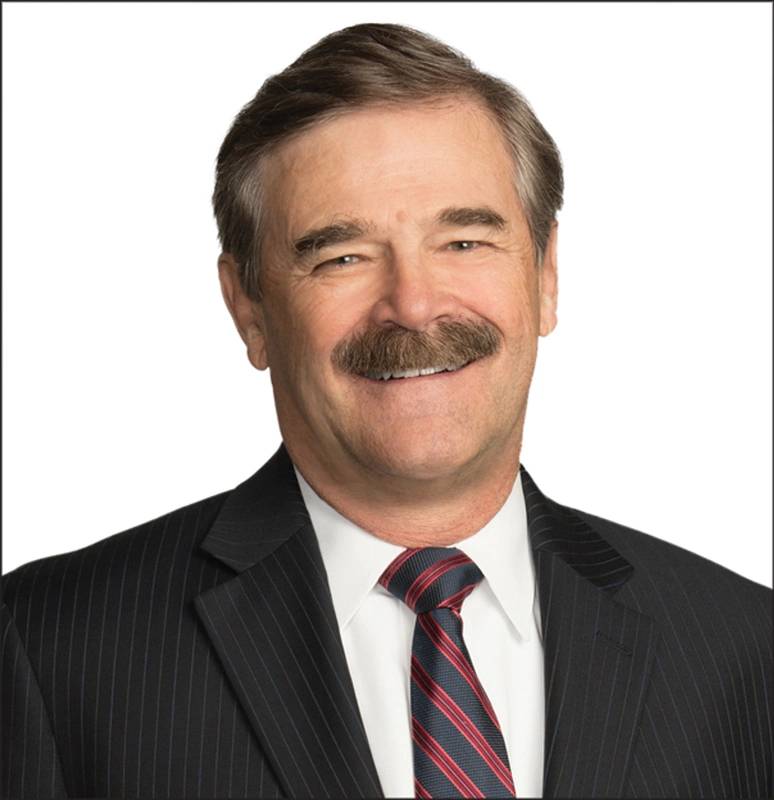 Jonathan K. Waldron is a partner in the Blank Rome's Washington, D.C., office who concentrates his practice in maritime, international and environmental law, including maritime security. He served in the U.S. Coast Guard for 20 years, attaining the rank of commander, and was senior counsel to the Marine Spill Response Corporation.
Jonathan K. Waldron is a partner in the Blank Rome's Washington, D.C., office who concentrates his practice in maritime, international and environmental law, including maritime security. He served in the U.S. Coast Guard for 20 years, attaining the rank of commander, and was senior counsel to the Marine Spill Response Corporation. -
- MTSA: Another Key Layer of Port Security Maritime Reporter, Mar 2004 #17
The Layered Defense. This classic military strategy has been used as a primary approach for defending a valuable target, infrastructure or piece of property for centuries. Medieval rulers had wide moats and drawbridges surrounding their castles, followed by high walls and armies ready with flaming
-
- Caribbean Security Challenges Maritime Reporter, Mar 2014 #44
, security, stability, the environment and sovereignty. A diverse group of stakeholders gathered in Providenciales, Turks and Caicos Islands (TCI) to discuss those challenges and reaffirm their commitment to address them. A major theme throughout the conference was that partnerships and collaboration are
-
- The Treatment of Foreign Seafarers Maritime Reporter, May 2014 #16
any other group that enters the country without breaking the law. The general rule is that all persons who are not U.S. nationals or permanent residents must have a visa to enter the United States. Persons desiring to become U.S. citizens or permanent residents must obtain an immigrant visa. Most other
-
- NAVY SEALIFT SHIP PROGRAM TO INJECT $1.3 BILLION INTO U.S. MARITIME INDUSTRY DEFENSE DEPARTMENT PLANNING 5 YEAR PROGRAM Maritime Reporter, Feb 1991 #46
. National Security Sealift Policy The President has approved the following Sealift policy guidelines: First, the U.S.-owned commercial ocean carrier industry, to the extent it is capable, will be relied upon to provide Sealift in peace, crisis and war. This capability will be augmented during crisis
-
 )
March 2024 - Marine Technology Reporter page: 48
)
March 2024 - Marine Technology Reporter page: 48. . .Birns, Inc. . . . . . . . . . . . . . . . . . . . . . . . . . . .www.birns.com . . . . . . . . . . . . . . . . . . . . . . . . . . . . . . .Please visit us online 19 . . . . .Blueprint Subsea . . . . . . . . . . . . . . . . . . . .www.blueprintsubsea.com . . . . . . . . . . . . . . . . . . . . . .+44 (0)
-
 )
March 2024 - Marine Technology Reporter page: 44
)
March 2024 - Marine Technology Reporter page: 44. Scandinavia (BUVI) to join its international sales team. Image courtesy Unique Group Sealing the deal(s) @ Oi ‘24 mating the object identi? cation process using the SAS Target in a single work? ow. The sensor’s 360-degree scanner and Assistant. The application runs in the background, leaving us- high collection
-
 )
March 2024 - Marine Technology Reporter page: 33
)
March 2024 - Marine Technology Reporter page: 33regulated industry in the world.” How- ever, commercial success depends on many factors, not least a predictable OPEX. Over the past four years, SMD has worked with Oil States Industries to calculate cost per tonne ? gures for prospective customers. Patania II uses jet water pumps to Oil States’
-
 )
March 2024 - Marine Technology Reporter page: 32
)
March 2024 - Marine Technology Reporter page: 32- the Pentagon is expected to deliver an ac- light plastic tracks and buoyant syntactic foam. The collec- tion plan on nodules by March 2024. tion vehicle uses sonar to identify the position of the nodules UK-based Soil Machine Dynamics (SMD) designed, devel- and has attained collection ef? ciency rates
-
 )
March 2024 - Marine Technology Reporter page: 27
)
March 2024 - Marine Technology Reporter page: 27SEA-KIT USV Maxlimer returning from HT-HH caldera in Tonga. © SEA-KIT International data and further assess ecosystem recov- ery. What is known, noted Caplan-Auer- bach, is that the impact of submarine vol- canoes on humans is rare. “The HT-HH eruption was a tragedy, but it was very unusual. It let us
-
 )
March 2024 - Marine Technology Reporter page: 25
)
March 2024 - Marine Technology Reporter page: 25mobilized away still had abundant life, including the Tonga Eruption Seabed Mapping Even before the recent HT-HH erup- corals, sponges, star? sh and mussels. Project (TESMaP) to understand the ex- tion, subsea technology helped scien- This indicated the resilience of certain tent of impact and inform
-
 )
March 2024 - Marine Technology Reporter page: 9
)
March 2024 - Marine Technology Reporter page: 9from marinas along the western coast. The exact number of lizing laser detection systems can detect mines just below the mines, as well as their locations, remains largely a mystery, surface, even those hiding in murky water. The Airborne Laser although reports suggest that over three hundred have been
-
 )
March 2024 - Marine Technology Reporter page: 6
)
March 2024 - Marine Technology Reporter page: 6(NOAA), and hai Ocean University in 2018. He proposed making thick wall Oceanographer of the Navy. He has a bachelor’s degree from glass spheres to Nautilus Marine Service/Vitrovex (Germany) the U.S. Naval Academy, and master and doctoral degrees from that opened the hadal depths to routine exploration
-
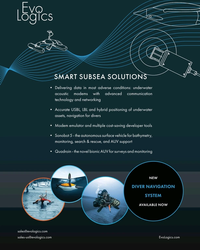 )
March 2024 - Marine Technology Reporter page: 2nd Cover
)
March 2024 - Marine Technology Reporter page: 2nd CoverSMART SUBSEA SOLUTIONS • Delivering data in most adverse conditions: underwater acoustic modems with advanced communication technology and networking • Accurate USBL, LBL and hybrid positioning of underwater assets, navigation for divers • Modem emulator and multiple cost-saving developer tools • Sonobot
-
 )
April 2024 - Maritime Reporter and Engineering News page: 48
)
April 2024 - Maritime Reporter and Engineering News page: 48& CHAINS MILITARY SONAR SYSTEMS tel:+44 (0) 1752 723330, [email protected] , www.siliconsensing.com Anchor Marine & Supply, INC., 6545 Lindbergh Houston, Massa Products Corporation, 280 Lincoln Street, SONAR TRANSDUCERS Texas 77087 , tel:(713) 644-1183, fax:(713) 644-1185, Hingham, MA 02043-1796
-
 )
April 2024 - Maritime Reporter and Engineering News page: 41
)
April 2024 - Maritime Reporter and Engineering News page: 41Nautel provides innovative, industry-leading solutions speci? cally designed for use in harsh maritime environments: • GMDSS/NAVTEX/NAVDAT coastal surveillance and transmission systems • Offshore NDB non-directional radio beacon systems for oil platform, support vessel & wind farm applications
-
 )
April 2024 - Maritime Reporter and Engineering News page: 38
)
April 2024 - Maritime Reporter and Engineering News page: 38operational autonomy of the BP re? nery, two miles from the Port of Castellón in Spain. up to eight hours, providing an ef? cient and non-polluting solu- Using its electric line handling tug Castalia, Consulmar towed tion for mooring operations. In addition to mooring, the mul- the steel mooring lines from
-
 )
April 2024 - Maritime Reporter and Engineering News page: 35
)
April 2024 - Maritime Reporter and Engineering News page: 35. FORCE Technology’s upcoming DEN-Mark2 math- lock around 50-80 times a day. It has ematical model release for its augmented reality SimFlex4 tug W changed us. Half the people surveyed and ship simulator will offer unprecedented model accuracy in a 2022 King’s College London study said that they feel like
-
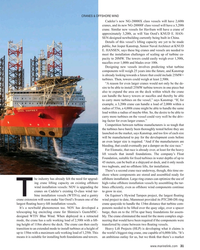 )
April 2024 - Maritime Reporter and Engineering News page: 31
)
April 2024 - Maritime Reporter and Engineering News page: 31and thereby be able to carry more turbines on the vessel,” says Kanstrup. “If, for example, a 3,200t crane can handle a load of 2,000t within a radius of 55m, a 4,000t crane might be able to handle the same load within a radius of maybe 68m. So, the desire to be able to carry more turbines on the
-
 )
April 2024 - Maritime Reporter and Engineering News page: 29
)
April 2024 - Maritime Reporter and Engineering News page: 29. Navy photo by Bill Mesta/released U.S. Navy photo by Ryan Carter Rear Adm. Philip Sobeck, Commander, United States Navy’s Military Sealift Command, visits USNS Patuxent (T-AO 201) for a tour of the ship at Naval Station Norfolk, Va., November 20, 2023. ENDLESS SUPPLY OF MARINE HARDWARE ! &"$)$?""?!!&"$l •
-
 )
April 2024 - Maritime Reporter and Engineering News page: 28
)
April 2024 - Maritime Reporter and Engineering News page: 28for the Mis- sile Defense Agency, and it travels with its support ship, the MV Hercules. For our Service Support ships, we have the two hospital ships, USNS Mer- cy and Comfort; two rescue and salvage ships; two submarine tenders; and the Sixth Fleet ? agship, USS Mount Whit- ney, that has a combined
-
 )
April 2024 - Maritime Reporter and Engineering News page: 27
)
April 2024 - Maritime Reporter and Engineering News page: 27RADM PHILIP SOBECK, MILITARY SEALIFT COMMAND With COVID, we had to make some hard choices for our Do your CIVMARs have upward mobility? mariners because we couldn’t rotate. Many of our mariners The Navy has Sailors who become “Mustangs,” and work found other employment, and were able to use their skills
-
 )
April 2024 - Maritime Reporter and Engineering News page: 26
)
April 2024 - Maritime Reporter and Engineering News page: 26replaced.” Rear Adm. Philip Sobeck, Commander, United States Navy’s Military Sealift Command Military Sealift Command’s expeditionary fast transport ship USNS Burlington (T-EPF 10) pulls into Joint Expeditionary Base Little Creek-Fort Story, Feb. 14. USNS Burlington is the U.S. Navy’s newest expeditionary
-
 )
April 2024 - Maritime Reporter and Engineering News page: 25
)
April 2024 - Maritime Reporter and Engineering News page: 25RADM PHILIP SOBECK, MILITARY SEALIFT COMMAND Photo by Brian Suriani USN Military Sealift Command From a global supply chain perspective, What makes MSC so vital to the we’ve learned a lot about dealing with Navy’s ? eet and our military disruptions. COVID delivered a big forces around the world? wake-up
-
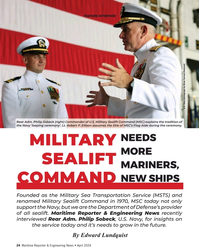 )
April 2024 - Maritime Reporter and Engineering News page: 24
)
April 2024 - Maritime Reporter and Engineering News page: 24FEATURE INTERVIEW U.S. Navy photograph by Brian Suriani/Released Rear Adm. Philip Sobeck (right) Commander of U.S. Military Sealift Command (MSC) explains the tradition of the Navy ‘looping ceremony’. Lt. Robert P. Ellison assumes the title of MSC’s Flag Aide during the ceremony. NEEDS MILITARY MORE
-
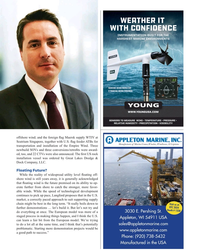 )
April 2024 - Maritime Reporter and Engineering News page: 23
)
April 2024 - Maritime Reporter and Engineering News page: 23and installation of the Empire Wind. Three newbuild SOVs and three conversions/retro? ts were award- ed, too, and 22 CTVs were also announced. The ? rst US rock installation vessel was ordered by Great Lakes Dredge & Dock Company, LLC. Floating Future? While the reality of widespread utility level ? oating
-
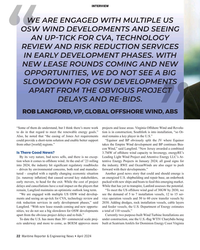 )
April 2024 - Maritime Reporter and Engineering News page: 22
)
April 2024 - Maritime Reporter and Engineering News page: 22INTERVIEW WE ARE ENGAGED WITH MULTIPLE US OSW WIND DEVELOPMENTS AND SEEING AN UP-TICK FOR CVA, TECHNOLOGY REVIEW AND RISK REDUCTION SERVICES IN EARLY DEVELOPMENT PHASES. WITH NEW LEASE ROUNDS COMING AND NEW OPPORTUNITIES, WE DO NOT SEE A BIG SLOWDOWN FOR OSW DEVELOPMENTS APART FROM THE OBVIOUS
-
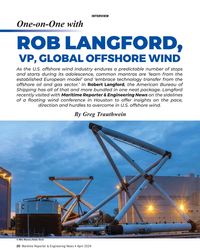 )
April 2024 - Maritime Reporter and Engineering News page: 20
)
April 2024 - Maritime Reporter and Engineering News page: 20INTERVIEW One-on-One with ROB LANGFORD, VP, GLOBAL OFFSHORE WIND As the U.S. offshore wind industry endures a predictable number of stops and starts during its adolescence, common mantras are ‘learn from the established European model’ and ‘embrace technology transfer from the offshore oil and gas
-
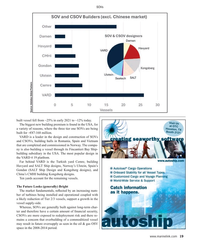 )
April 2024 - Maritime Reporter and Engineering News page: 19
)
April 2024 - Maritime Reporter and Engineering News page: 19SOVs Source: Intelatus Global Partners built vessel fell from ~25% in early 2021 to ~12% today. Visit Us The biggest new building premium is found in the USA, for at OTC Houston, TX a variety of reasons, where the three tier one SOVs are being Booth 2121 built for ~€87-168 million. VARD is a leader in
